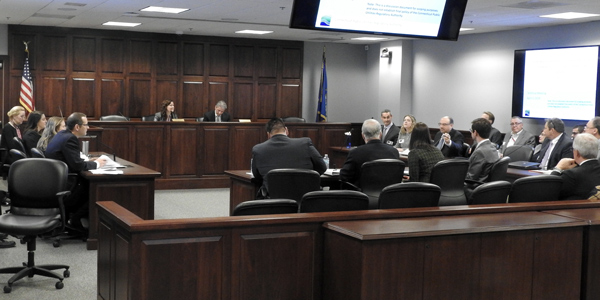By Michael Kuser
NEW BRITAIN, Conn. — Utility representatives and other stakeholders shared their views on evolving cost drivers, changing customer demand and new technologies at the Connecticut Public Utilities Regulatory Authority’s first-ever technical conference on grid modernization on Tuesday (17-12-03).
“We need to have technologies in place that understand how the system is operating in real time, with power coming from any direction on the system,” said Chuck Eves, director of engineering and strategic planning at Avangrid subsidiary United Illuminating (UIL).
Eversource Energy filed comments ahead of the conference calling for “foundational investments in sensing and monitoring communications, analytics, automation and control solutions.”
Jennifer Schilling, Eversource’s director of grid modernization, said her company breaks down its investments “into peak load, new customer growth, reliability and ageing infrastructure, and basic business, which includes capital repairs.”
The new opportunities arising from the growth in distributed energy resources are “adding a new dimension in our planning process,” which is why the company supported the timing of the technical conference, Schilling said.
“The nature of the changes in demand and the forecasting will be important in terms of thinking about what do we need to do differently to be able to say, ‘OK, if I have these categories of investment, how are they likely to change in the future?’” Schilling said.
Using Data
Connecticut Green Bank Associate Director Anthony Clark said his organization’s current investments are following and helping to boost customer demand, “but they are not following grid demand much at all. We just don’t have that insight.”
Clark thanked PURA, the state’s Department of Energy and Environmental Protection and UIL for helping the Green Bank start “really digging into this process on the grid side” through clean energy pilot programs.
“In much of the discussion here we’ve talked about the challenge of having solar PV or other resources where there isn’t sufficient data or resolution into the resource or ability to control it,” Clark said. “The technologies themselves are becoming smarter, so we’re looking at deploying smart inverters that will actually sense grid conditions and respond to them.”
Christian Bilcheck, vice president for smart grids innovation at Avangrid, said it’s important to think of DER in the aggregate, not as individual elements.
The utility is not necessarily going to have the answers to a lot of questions in the early days, he said.
“I can picture a data request coming in and it will look like we’re not sharing information, but we don’t have DER adoption modeling forecasts for circuits and substations right now,” Bilcheck said.
“It gets complicated, but I think if we keep approaching it from a practical perspective, we’ll get there,” he said. “Not just the data needs, but I think the goal of the data is to help inform the types of investments that we should be looking forward to, how DERs can play a role in that frame and even help shape policy.”
Lauren Savidge, DEEP director of energy supply, said the agency is learning from what other states are doing with DER, citing a recent Michigan Public Service Commission solar program report “that was pretty thorough on compensation for solar, how different customers in their territory use solar.”
Cost and Sustainability
PURA Chair Katie Dykes said, “The cost-effectiveness testing will help us learn a lot about — particularly from the utilities’ perspective — what the grid currently can do and where the limitations are.”
Eves said it’s important to consider the long-term sustainability of solutions “as we evaluate the lifecycle costs of the choices we make, to sustain those into the future, five, 10, 20, 40 years down the road.”
In its comments, the Acadia Center said that any calculation of cost-effectiveness should be aligned with the state’s consumer, energy and environmental goals.
“Cost-benefit frameworks should be designed or expanded to fully reflect priorities such as reducing energy bills and reducing consumers’ energy burden, addressing climate change, enhancing consumer control and choice, and systemwide efficiency,” Acadia said.
PURA Commissioner Michael Caron returned the conversation to what Connecticut can learn from other jurisdictions.
“In California and Hawaii, they are blazing the trail ahead of us from the perspective of penetration and how they’re dealing with those issues, so there’s a lot to learn from what’s occurred in those states … learning from their mistakes as well as from their successes,” Eves said.
PURA is seeking written follow-up comments on the technical conference by April 10 and will later this month issue a final notice of scope of procedure for its exploration into the issues of grid modernization. The agency plans to begin discovery in the coming months and form working groups by this summer before soliciting reports from them in the fall.








